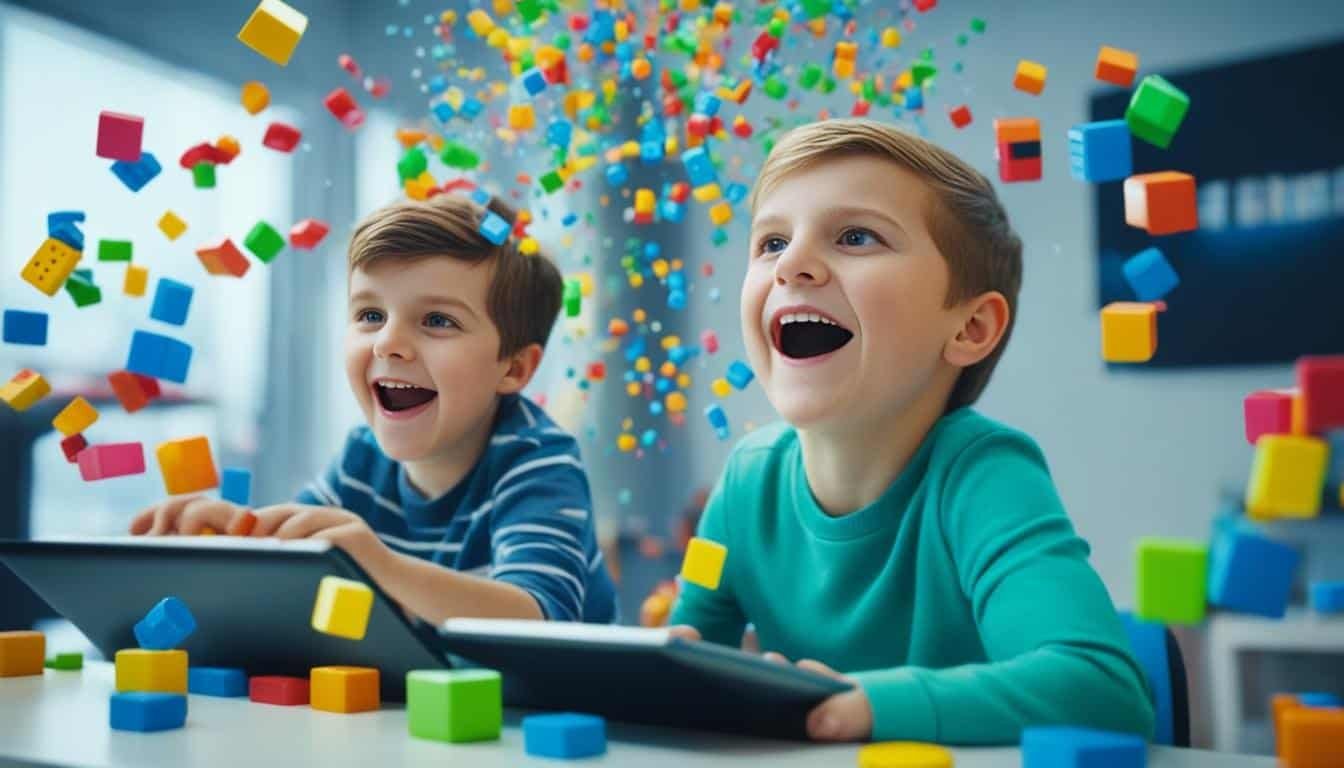Coding for Kids: Fun Learning for Young Minds
|
Getting your Trinity Audio player ready...
|
Introducing kids to the world of coding at an early age can have numerous benefits for their development. Not only does it foster creativity and critical thinking, but it also equips them with valuable problem-solving skills. Coding classes for children provide a fun and engaging way for young minds to learn this essential skill that will undoubtedly shape their future.
Tynker is a highly regarded coding program for kids and teens that offers an interactive and enjoyable learning experience. With over 5,000 coding lessons, award-winning courses, and even live expert coaching, Tynker provides a comprehensive curriculum that ensures children receive the best coding education possible. Trusted by leading brands and embraced by a global community of students and educators, Tynker is the go-to resource for coding enthusiasts.
Key Takeaways:
- Coding classes for kids provide a fun and engaging way to learn programming.
- Tynker offers a comprehensive coding curriculum with live coaching and award-winning courses.
- Learning to code at a young age promotes critical thinking and problem-solving skills.
- Tynker is trusted by leading brands and has a global community of students and educators.
- Introduce your child to coding and set them up for success in a technology-driven world.
The Basics of Coding for Kids
When introducing kids to coding, it’s important to start with the basics. Visual programming languages like Scratch and Blockly are designed to make learning coding easier and more engaging for children. These languages use blocks and a drag-and-drop interface, allowing kids to create simple programs without worrying about complex syntax. As kids progress, they can move on to text-based programming languages like Python and JavaScript, which offer more advanced features and functionality.
Scratch, developed by the MIT Media Lab, is an intuitive and beginner-friendly programming language that enables kids to create interactive stories, games, and animations. By dragging and dropping blocks of code, kids can learn fundamental coding concepts while expressing their creativity. Scratch provides a visual interface that represents coding concepts in a tangible way, making it suitable for children as young as 8 years old.
Blockly, an open-source project by Google, is another visual programming language that builds on Scratch’s drag-and-drop functionality. It allows kids to create more complex programs by organizing blocks of code into sequences and loops. Blockly is widely used in educational settings and is suitable for kids who have gained some coding experience with Scratch.
As kids become more comfortable with visual programming languages, they can transition to text-based languages like Python and JavaScript. Python, known for its clean and readable syntax, is a versatile language that is widely used in web development, data analysis, and artificial intelligence. JavaScript, on the other hand, is the language of the web, enabling kids to create interactive websites and games.
By introducing kids to these programming languages, they not only develop valuable coding skills but also gain problem-solving abilities and logical thinking that can be applicable in various disciplines. As they progress in their coding journey, kids can unlock a multitude of opportunities to create their own projects and bring their ideas to life.
Benefits of Kids Coding Classes
Kids coding classes offer a wide range of benefits that go beyond just learning to code. These classes play a crucial role in the development of children’s cognitive and problem-solving skills, promoting persistence and resilience, and even contributing to academic success.
Developing Computational Thinking
Learning to code helps children develop computational thinking, which is the ability to break down complex problems into smaller, more manageable parts. It involves analyzing problems, organizing data, and creating step-by-step solutions. Computational thinking is a fundamental skill that can be applied not only in coding but also in various academic disciplines and real-life situations.
Promoting Problem-Solving Skills
Problem-solving is at the core of coding. Kids coding classes empower children to think critically, approach challenges creatively, and come up with innovative solutions. By experimenting, iterating, and debugging their code, children learn to tackle problems systematically and develop a problem-solving mindset that extends beyond the realm of coding.
“Coding teaches you how to think.” – Steve Jobs
Promoting Persistence and Resilience
Coding is not always easy, and children often encounter hurdles and bugs along their coding journey. By persevering through these challenges, kids develop persistence and resilience. They learn to embrace setbacks as opportunities for growth, find alternative solutions, and never give up on finding the answer. These qualities are invaluable in building resilience and adaptability in the face of future challenges.
Direct Relationship Between Coding and Academic Success
Research has shown a direct relationship between learning to code and academic success. The skills acquired through coding, such as logical reasoning, attention to detail, and problem-solving, contribute to improved performance in subjects like math and science. Coding enhances critical thinking skills and fosters a deeper understanding of abstract concepts, providing a strong academic foundation.
Moreover, coding engages children in active learning, making education more interactive and enjoyable. The hands-on nature of coding classes encourages students to take ownership of their learning, leading to increased motivation and academic achievement.
By enrolling your child in coding classes, you not only introduce them to a valuable 21st-century skill but also provide them with a host of benefits that go beyond the computer screen. Developing computational thinking, problem-solving skills, promoting persistence and resilience, and enhancing academic success are just a few of the many advantages that coding offers to young minds.
Coding Classes and Collaborative Learning
Coding classes provide a unique and interactive learning experience for kids, offering more than just coding skills. One of the key advantages of coding classes is the opportunity for peer-to-peer learning, fostering teamwork and creating a supportive learning community.
In coding classes, children often engage in group projects and hackathons, where they can collaborate with their peers, exchange ideas, and work together to solve coding challenges. This collaborative learning environment not only enhances their coding skills but also promotes teamwork and communication.
“Collaboration allows students to build upon each other’s strengths and learn from their peers. It encourages them to think critically, explore different perspectives, and come up with creative solutions,” says Sarah Thompson, a coding instructor at KidsCodeCamp.
Moreover, online forums and social networks play a significant role in creating a supportive learning community. Kids can connect with like-minded individuals, ask questions, and seek help from their peers. These platforms provide a safe and inclusive space for kids to share their coding projects, exchange feedback, and inspire one another.
“Being part of a supportive learning community helps kids feel encouraged, motivated, and confident in their coding abilities. It creates a sense of belonging and provides a growth mindset that encourages them to continue learning and improving,” notes Amy Johnson, a coding educator.
To illustrate the collaborative nature of coding classes, consider the following example:
| Activity | Description |
|---|---|
| Group Project: Building a Website | Students are divided into groups and tasked with creating a website on a chosen topic. Each group member contributes their coding skills and ideas to design and develop different sections of the website, such as home page, about page, and contact page. They collaborate, share their progress, provide feedback, and ultimately create a dynamic website as a team. |
| Hackathon: Creating a Game | Students participate in a coding hackathon where they have a limited time to develop a game using the coding languages they have learned. They form teams and work together to brainstorm game ideas, divide tasks, and bring their vision to life. Through collaboration and teamwork, they create innovative, playable games and present them to the class. |
By engaging in peer-to-peer learning, teamwork, and being part of a supportive learning community, children in coding classes not only gain coding skills but also develop essential 21st-century skills such as collaboration, communication, and problem-solving.
Choosing the Right Coding Class for Your Child
When it comes to enrolling your child in a coding class, it’s crucial to make an informed decision. Assessing your child’s interests and skill level, evaluating available resources and platforms, and considering cost and commitment are key factors to consider.
Assessing Interests and Skill Level
Start by understanding your child’s interests and the type of coding they are most drawn to. Some kids may prefer video game development, while others might be interested in web design or robotics. Matching their interests with the right coding class will ensure they stay engaged and motivated to learn.
Additionally, consider your child’s skill level. Some coding classes may be designed for beginners, while others may require prior coding experience. Finding a class that aligns with your child’s skill level will help them progress at a pace that suits their development.
Evaluating Available Resources and Platforms
Take the time to explore the available coding resources and platforms. There are various options, such as online classes, in-person workshops, and after-school programs. Each platform offers unique benefits, so it’s essential to consider factors like accessibility, learning environment, and instructional format.
For online classes, ensure that the platform provides interactive lessons, live coding sessions, and opportunities for peer collaboration. In-person workshops can offer hands-on experience and immediate feedback from instructors. Consider your child’s learning style and preferences when selecting the most suitable resource or platform.
Considering Cost and Commitment
Cost and commitment are important considerations when choosing a coding class for your child. Evaluate the financial investment required for the class, including any additional materials or software licenses. Consider whether the class is a one-time payment or a subscription-based model.
Furthermore, assess the time commitment required. Some coding classes may last for a few weeks, while others may extend over several months. Consider your child’s schedule and other commitments to ensure they can fully dedicate themselves to the class.
By carefully assessing your child’s interests and skill level, evaluating available resources and platforms, and considering cost and commitment, you can make an informed decision when choosing the right coding class for your child.
Supporting Your Child’s Coding Journey
As your child embarks on their coding journey, it’s important to provide them with the necessary support and encouragement to help them thrive. Coding can be challenging at times, but with practice and perseverance, your child can overcome obstacles and achieve their goals. Here are some ways you can support your child’s coding journey:
1. Encouraging Practice and Perseverance
Learning to code requires regular practice to build and reinforce coding skills. Encourage your child to dedicate time each day or week to coding exercises and projects. Emphasize the importance of practice and remind them that mistakes and setbacks are part of the learning process. By promoting a growth mindset, your child will develop resilience and the ability to persevere through challenges.
2. Providing Constructive Feedback and Praise
When reviewing your child’s coding projects, provide constructive feedback that helps them improve their skills. Focus on specific areas where they excel and offer suggestions for areas of improvement. Be sure to also praise their efforts and accomplishments, as positive reinforcement boosts their confidence and motivation.
3. Celebrating Milestones and Accomplishments
As your child progresses in their coding journey, celebrate their milestones and accomplishments. Acknowledge their hard work and dedication by organizing a small celebration or rewarding them with a special treat. By recognizing their achievements, you instill a sense of pride and encourage them to continue reaching for new goals.
4. Exploring Additional Resources and Opportunities
There are many additional resources and opportunities available to enhance your child’s coding education. Consider enrolling them in coding camps, where they can learn from expert instructors and collaborate with peers who share their passion. Encourage them to participate in coding competitions to challenge themselves and showcase their skills. Online tutorials and open-source projects provide practical experience and allow your child to explore coding beyond the classroom.
Remember, your support and encouragement play a crucial role in your child’s coding journey. By fostering a positive learning environment and providing opportunities to grow, you set the stage for their success.
| Resource | Description |
|---|---|
| Coding Camps | Intensive programs that offer hands-on coding experience and mentorship |
| Coding Competitions | Events where students can showcase their coding skills and problem-solving abilities |
| Online Tutorials | Guided lessons and video tutorials that cover various coding concepts and projects |
| Open-Source Projects | Collaborative coding projects where your child can contribute and learn from others |
The Broader Impact of Kids Coding Classes
Kids coding classes have a broader impact beyond just learning to code. They play a crucial role in promoting digital literacy and responsible technology use among young learners. By teaching kids about online safety, privacy, and ethical considerations, coding classes empower them to navigate the digital world confidently and responsibly.
In addition to digital literacy, coding classes inspire the next generation of innovators and change-makers. By encouraging creativity and innovation, these classes provide young minds with the tools and skills necessary to tackle real-world problems. Through coding, kids learn how technology can be harnessed for positive social impact and develop a deep understanding of how to use their technical skills to create meaningful change in various fields.
To illustrate the broader impact of kids coding classes, consider the following example:
“Max, a student who attended a coding class, developed an app that connects local farmers with consumers, promoting sustainable and local food consumption. Through coding, Max learned to develop an understanding of both technical skills and social consciousness, inspiring him to create a solution that addresses real-world challenges. Max’s app not only supports local farmers but also encourages responsible food consumption.”
By inspiring kids to use their coding skills for positive purposes, coding classes empower them to become the innovators and change-makers of the future.
| Benefits of Kids Coding Classes | Examples |
|---|---|
| 1. Promoting digital literacy | Kids learn about online safety, privacy, and ethical considerations. |
| 2. Responsible technology use | Children are empowered to navigate the digital world responsibly. |
| 3. Inspiring innovation and creativity | Young learners develop the skills to address real-world challenges through coding. |
| 4. Creating positive social impact | Coding classes encourage kids to use their skills to bring about meaningful change. |
Conclusion
As coding for kids continues to gain popularity, it is clear that this fun and engaging activity offers a plethora of benefits. By participating in coding education, children can develop critical thinking and problem-solving skills that will serve them well in the future. Moreover, coding classes provide a platform for collaboration and foster creativity, allowing kids to unleash their innovative potential.
When it comes to choosing the right coding class for your child, it’s important to consider their interests and skill level. By selecting a program that aligns with their needs, you can ensure that they receive a solid foundation in coding education. Additionally, supporting your child’s coding journey by encouraging practice and perseverance is key to their success.
It’s crucial to recognize the broader impact of coding education. Through coding classes, children not only develop coding skills but also gain digital literacy and an understanding of responsible technology use. This knowledge is invaluable in a technology-driven world where technology plays a prominent role in our daily lives. By enrolling your child in a coding program, you are investing in their future and equipping them with the skills they need to become the innovators and change-makers of tomorrow.







